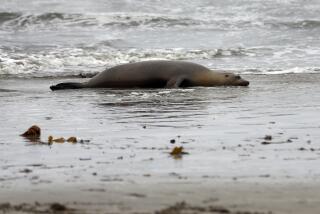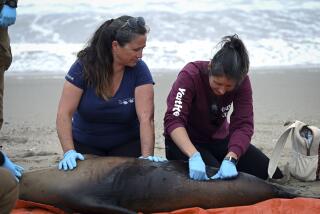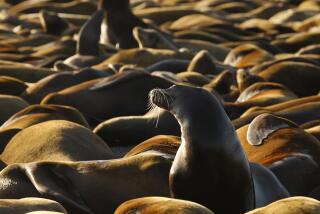Series of Deadly Diseases Threatens Coral Reef Off Florida
- Share via
KEY WEST, Fla. — From a few feet away, the corals appear scalded, as if someone took a jar of acid and spattered them at random. Look closer and the tissue seems to have melted away, leaving only the bleached skeletons of what were once living animals.
Local divers call it “White Pox,” the latest in a string of diseases that have struck like biblical plagues the only living coral reef along the continental United States. Unknown a year ago, the pox is spreading through corals near Key West that already have been thinned by illnesses with names like “Black Band” and “White Plague II.” In some spots, the new disease alone has wiped out 80% of the animals in a single year.
Much about the disease remains a mystery. Just as with several of the other new maladies, researchers don’t yet know how it spreads, or if it’s caused by a bacterium, fungus or virus. But among marine scientists there’s a suspicion that the diseases themselves are not necessarily new. It may be that something else is causing the corals to become susceptible to getting sick: Pollution.
“The problems of the land are extending to the reefs,” said James Porter, a University of Georgia marine ecologist. A leading authority on White Pox, Porter is investigating a possible link to the dumping of human sewage and farm chemicals around the Keys and nearby Florida Bay--a connection that already has been established for other coral diseases.
“The proof,” he cautions, “can be elusive.”
But whatever is causing it, White Pox is adding to the sense of alarm among those fighting to preserve Florida’s reefs. Diseases and direct damage by humans have wiped out colonies all along the Florida reef track, which runs from Biscayne Bay near Miami to the Dry Tortugas 67 miles west of Key West.
The destruction mirrors similar declines elsewhere in the Caribbean, in Asia and wherever the growth of human populations is colliding with fragile ecosystems offshore.
Coral reefs are created by colonies of tiny, single-celled animals that secrete calcium carbonate to form a hard outer skeleton. New colonies grow on the skeletons of dead corals in a process that builds vast reef structures over thousands of years.
The death of reefs--which are sometimes called “rain forests of the sea” because of their remarkable biological richness--is viewed with concern because of the critical role corals play in supporting life in the oceans. Though they cover less than 1% of the Earth’s surface, they are home to a quarter of all marine fish species.
For humans, the destruction of reefs could hasten the collapse of fisheries by wiping out spawning and feeding grounds. Tourism may be threatened too: The reefs off the Florida Keys are the world’s top destination for amateur snorklers and divers.
“I’ve seen corals dying that were here when Hemingway was around,” said Craig Quirolo, a Key West diver turned activist who is credited with discovering White Pox. “This is a signal to the human race that things are wrong in the ocean.”
On a recent morning, Quirolo nudged his small boat through a familiar stretch of surf.
Underwater, the living corals are blanketed with an oily film of sediment and algae. Here and there, amid pockmarks from boat anchors, are bare patches, which Quirolo said mark the latest advance of White Pox.
The disease, which shows up first as splotch-like marks, affects only Elkhorn corals, antler-shaped hard corals that are the dominant reef-building animals in Florida’s shallow waters.
Porter, who worked closely with Quirolo in identifying White Pox, said the disease spreads quickly and is highly lethal, killing 70% to 80% of the corals it infects. Watching the progression of the disease, he said, is “scary stuff.”
In the first year it was detected, the disease turned up three “hot spots” in the reefs around Key West. Because coral diseases generally spread only in warmer water, the deterioration of the corals appeared to have halted with the onset of winter.
But the respite is hardly long enough to reverse what local divers describe as two decades of steady decline in the Florida reef.
More to Read
Sign up for Essential California
The most important California stories and recommendations in your inbox every morning.
You may occasionally receive promotional content from the Los Angeles Times.










